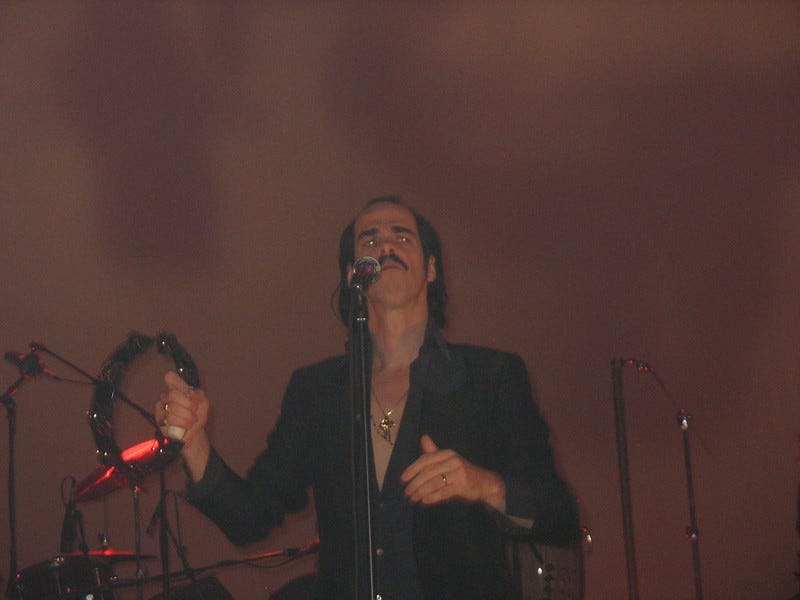Human-Composed: Why AI Creation and Human Creativity Remain Fundamentally Different
A response to a recent MIT Technology Review article that hammered home the idea that AI and human creation are the same. They're not.
While I appreciate Nitin Nohria's thoughtful exploration of creativity's recombinatorial nature in his MIT Technology Review piece, his comparison between human artistic influence and AI generation overlooks a crucial distinction that goes to the heart of what makes art meaningful. The difference isn't merely technical—it's existential.
Much is made in his piece about how artists build on the works of others, as if generative AI was just doing the same thing when a prompt turns into a piece of art, a novel in the style of another writer, or a video game that seems eerily similar to a highly successful one. Nohria’s view is not uncommon, but it is generally one that comes from those with a technological background rather than a creative one. To wit, when Van Gogh reinterpreted Keisai Eisen's work, he didn't simply process and recombine visual elements based on statistical correlation learning. Van Gogh filtered Eisen's composition through decades of lived experience: his struggles with mental illness, his complex relationship with his brother Theo, his deep spiritual yearning, his observations of light and dark in the French countryside, and his revolutionary understanding of color theory developed through painstaking experimentation. The resulting work, while derivative, carries the weight of a human consciousness grappling with the torment and beauty of existence itself. More importantly, Van Gogh’s interest in Japanese art likely led to his use of bright colors, bold outlines, and spatial clarity.
This is fundamentally different from prompting an AI to "create in Van Gogh's style." Even with sophisticated tools like LoRAs, MCPs, or detailed profiles and prompts, what would emerge is a statistical synthesis of Van Gogh's visual patterns, not an authentically lived interpretation filtered through genuine experience. The AI has no relationship to suffering, no understanding of what it means to see sunlight break through clouds, no existential questions about mortality or meaning. It has processed data; it doesn't experience life.
The Perspective Problem
Knowing that AI draws from the world of content it has ingested and that it could produce something similar to copyrighted works vastly understates the larger issue here. When an AI model processes billions of pieces of art, it develops something close to an ‘average perspective.’ This is more akin to having no distinct perspective at all, rather than a perspective that is unique to a human artist, which is developed over time through living in the world. This is also troubling to many teachers who are now sometimes getting a classroom full of similar papers (with little to no personal perspective or independent thought), because so many are “written” entirely or with the help of ChatGPT.
Purely algorithmic creativity leans towards a kind of “creative least common denominator,” capable of producing technically proficient work that feels eerily hollow. The fact that this has become both more common and more acceptable isn’t a good thing for humanity at all.
The gaps in their knowledge are often as important to their art as the information they know in their souls.
Human artists, by contrast, bring irreducibly personal perspectives to their artwork. Frida Kahlo's immortal self-portraits aren't just some kind of stylistic exercise. They are visceral expressions of her physical pain, political conviction, and emotional turbulence. Jean-Michel Basquiat's graffiti-influenced paintings carry the weight of his experience as a Black artist navigating 1980s New York's art world. These artists’ perspectives can't be replicated through better prompting or more sophisticated algorithms. The gaps in their knowledge are often as important to their art as the information they know in their souls. Their artistic expressions emerged from the messy, contradictory, lived reality of being human.
The Value of Creative Struggle
There's profound value in the process of human creation that extends far beyond the final artwork. When a human artist wrestles with composition, experiments with techniques, makes mistakes and discoveries, they're not just producing content. They are actually developing as a person and an artist. They're building skills, processing emotions, and adding to the sum total of human expression and understanding that they can bring to their artwork.
“Reading maketh a full man; conference a ready man; and writing an exact man.” - Francis Bacon.
I often think of Bacon’s quote here and how it has resonance for all creative people (and let’s not add a time travel perspective and beat up Bacon for referencing ‘man’ because the word’s origin is ‘person’, not an adult cisgender male). The study of art, interaction with other artists, and the creation of art are all part of making us better people and leaving our mark on the world. Songwriter and novelist Nick Cave asserts that struggling with creativity is an essential part of making meaningful art. He certainly doesn’t mean you need more AI credits to get your work done properly.

This process matters immensely, both for the artist and for society. It's why we value a carefully crafted sculpture differently from a 3D-printed reproduction, even if they're visually identical (and the latter is possibly illegal). The sculpture carries the story of its creation—the artist's vision, struggle, growth, and intentionality. The reproduction, however technically impressive, lacks that human narrative, subtext, and markings of the grit to make it happen. That is why we pay more for a sculpture than we do for the 3D-printed version in the same shape.
The Content Saturation Problem
In our era of endless content proliferation, this distinction becomes even more crucial. We're drowning in machine-generated text, images, and videos that are often technically functional but spiritually vacant. In this frequent state of “Content Shock”, we encounter new formats that suit our consumption vehicles (omnipresent mobile devices, usually) with a compressed timeline to consume everything because more content awaits us further down the scroll. Our phones made us adapt to vertical format content like TikTok and its clones on other channels because they are convenient to the way we hold our phones, and we get lost in the endless stream.
We are bombarded with a seemingly infinite number of channels of material, too many streaming videos are made now, and they’re all competing with everything from the past. There is simply too much content, and the proliferation of it online is contributing to problems with AI models Credtent predicted long ago. More AI-generated work gets us further away from human art, and it's now literally destroying the models that made it. When anyone can generate a reasonable facsimile of art through prompting, scarcity and value naturally will shift to authentic human expression.
We already live in a world with various levels of quality in the work we consume. Think of how we pick the food we eat. People will choose between McDonald's, In-N-Out, and steakhouse burgers based on preference and budget. But when it comes to AI versus human-composed art, we're not just choosing between different qualities of the same thing; we're choosing between fundamentally different categories of experience. One offers the nourishment of genuine human expression. The other provides empty calories and perhaps a dopamine hit. That said, if that’s what people seek, I guess the world will give it to them, for better or worse.
Where AI Aligns With Creativity
AI technology is here to stay. If you choose to reject it, more power to you. But we should also see that AI has a place in creative work. Just make sure you do not let it replace the entirety of the creative process. Some artists are finding compelling ways to collaborate with AI tools, using them as starting points for ideation, exploration, or to expand their technical capabilities. From what we’ve seen of this new genre of artistic expression, the most successful AI-assisted art maintains clear human intentionality and perspective. The artist remains the (first and final) driving creative force, using AI as one tool among many. They keep an artist-in-the-loop mentality that everything should flow through a human lens at each stage of creation, rather than outsourcing the creative vision mostly or entirely.
This distinction matters because it shapes what kind of creative culture we build. If we treat AI-generated content as equivalent to human creativity, we risk devaluing the very human qualities that make art meaningful in the first place: personal struggle, lived experience, individual perspective, and the irreplaceable messiness of human consciousness grappling with existence.
This is what we teach in Credtent’s Ethical AI courses: Leaning in on your humanity, finding the synergy of AI to extend your work and not replace it, and ensuring that what goes on the canvas, the page, the track, or the digital video is uniquely YOURS and not just the sad average of everything everywhere. That’s what people will want more and more as we sink into the burgeoning chaos of modern content creation.
Another important distinction to call out is AI-use transparency, which, thankfully, Nohria discloses in his opinion piece. We at Credtent agree. The practice of AI transparency and disclosure is so important. Credtent enables this practice with a simple, distinctive three-badge system of Creative Origins. Credtent champions this idea as a fundamental practice for building trust in creative expression.

Research shows that audiences want to know whether the art that they are consuming was in any way generated by AI. Creative people have an obligation to make sure that their audience knows what went into their work. This is part of building an authentic relationship between an artist and their audience. There may come a time when AI creators attempt to engage audiences “authentically”, but I suspect that will be both more difficult and less satisfying for people.
The Future of Creativity
In the crystal ball, I anticipate a future where we'll see a bifurcation in creative work. Mass-market content will increasingly be AI-generated. Perhaps that's fine for many commercial applications, and certainly advertising is already embracing it, to the chagrin of many creatives in the space.
What about the creative work that seeks to move us, challenge us, or help us understand what it means to be human? Will it stay stubbornly human in origin? If so, that’ll happen with my blessing.
The artists who thrive will be those who lean into their irreducible humanity. Those unique perspectives, their personal struggles, their individual ways of seeing and interpreting the world will drive their work. They'll use whatever tools serve their vision, including AI, when appropriate, but the driving force will be distinctly human.
In this light, copyright concerns about AI training data represent more than legal technicalities. They are about ensuring space for authentic human creativity to flourish. While Nohria worries that copyright anxiety will hold back creativity, I'd argue that the real threat to creativity is treating human expression as just another dataset to be processed and recombined.
I believe more creative people will worry less about this issue when blanket creative licenses for AI training become the norm. This process will facilitate AI development while also respecting copyright and compensating creators (our goal at Credtent). With careful tracking of content that is made for commercial purposes, proper allocation of payments will be more effective. With transparency and disclosure, the world could embrace AI as the creative partner it can be. We can see a future where copyright is respected, tracking and disclosure are embraced, and fair use for fair compensation fuels human creativity with the financial support to create more amazing, human-composed artwork to light up the world.
The future will indeed offer us both human and AI-generated content. But let's not pretend they're the same thing. In a world increasingly filled with artificial content, the value of the genuinely human will only grow. That's not anxiety—that's recognition of what makes art truly worthy of our attention.
Learn more about Credtent at Credtent.org and join our platform for free opt-out of AI and licensing options.






